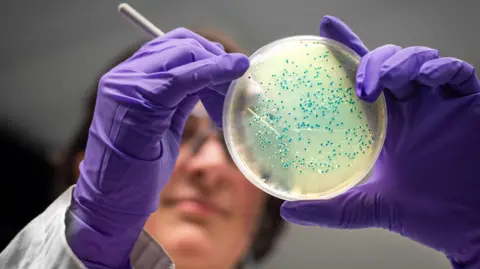**AI-Designed Antibiotics Open New Frontiers in the Battle Against Superbugs**
Recent developments from the Massachusetts Institute of Technology (MIT) have revealed a significant breakthrough in antibiotic research. Researchers have successfully utilized artificial intelligence (AI) to invent two potential antibiotics aimed at combating drug-resistant strains of gonorrhea and methicillin-resistant Staphylococcus aureus (MRSA). This innovative approach employs AI to design new compounds at the atomic level, with laboratory and animal tests indicating their effectiveness against these formidable superbugs.
The urgency of this advancement cannot be overstated. With antibiotic resistance becoming increasingly prevalent, resistant infections now account for over a million deaths annually. The over-prescription and misuse of antibiotics have allowed bacteria to evolve mechanisms to evade treatment, leading to a troubling shortage of new antibiotics over recent decades. By leveraging AI—specifically generative AI technology—researchers at MIT are optimistic that we may soon witness a resurgence in antibiotic discovery, potentially ushering in a “second golden age.”
In their recent publication in the journal *Cell*, the MIT team engaged with a staggering dataset of 36 million compounds, including those that have yet to be discovered. The initial phase involved training the AI using the chemical structures of known antibiotics and corresponding data on their efficacy against various bacterial species. By understanding how different molecular structures—composed of elements such as carbon, oxygen, hydrogen, and nitrogen—interact with bacterial growth, the AI was able to mimic and innovate new potential antibiotics.
Two methodologies were employed in the research. The first entailed a targeted search through a vast library of chemical fragments, leading to the identification of promising candidates from which to build new antibiotics. The second approach allowed the AI greater autonomy, permitting it to create antibiotic designs from scratch. Throughout this process, the researchers set stringent criteria to ensure the new compounds did not resemble existing antibiotics too closely and were unlikely to be toxic to humans.
As the researchers progressed to manufacturing, the top designs underwent rigorous testing against bacteria in laboratory conditions and infected mice, ultimately resulting in the identification of two promising drug candidates. The excitement among the research team is palpable, with Professor James Collins of MIT expressing enthusiasm about how generative AI can expedite and expand the development of novel molecules aimed at battling superbugs.
While the findings are encouraging, it is essential to note that these potential antibiotics are still in the preliminary stages. They require additional refinement and rigorous clinical testing, a process anticipated to take one to two years, before they can be considered for prescription use.
Experts are taking a cautious yet hopeful stance on this innovative approach. Dr. Andrew Edwards from the Fleming Initiative at Imperial College London emphasized the project’s significance, noting its considerable potential to revolutionize antibiotic development. Yet, he acknowledged that substantial work remains to test the safety and efficacy of these experimental drugs, a process that can often be long and fraught with uncertainty.
Moreover, the pharmaceutical landscape presents its own set of challenges. Once developed, how do we ensure there is a financial incentive for pharmaceutical companies to produce drugs that are ideally used sparingly? Antibiotics’ crucial role in health lies in preserving their effectiveness, which complicates potential commercial viability. Following a similar line of thought, Prof. Chris Dowson from the University of Warwick pointed out that while utilizing AI for antibiotic discovery is promising, economic factors must be weighed heavily against the backdrop of drug-resistant infections.
In conclusion, while the journey from AI-generated concept to clinically-prescribed antibiotic is lengthy and complex, the MIT team’s efforts mark a notable stride forward. As researchers across the globe continue to explore AI’s capabilities in medicinal development, there is hope for healthcare to combat the pressing challenge posed by antibiotic-resistant bacteria more effectively. The challenge remains—how to develop new treatments that are both innovative and economically feasible in a healthcare landscape that is rapidly evolving.












